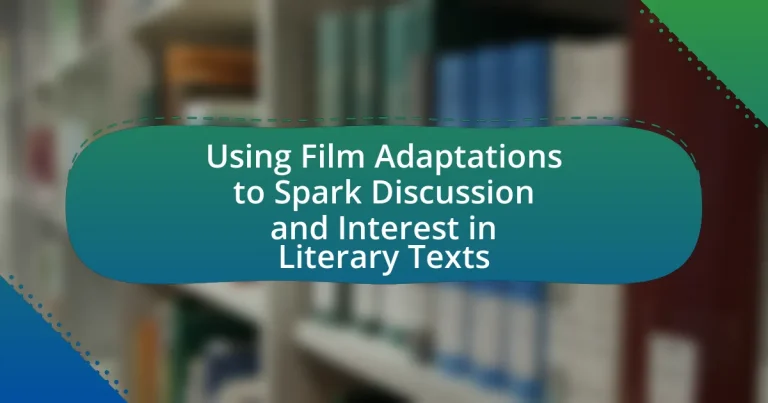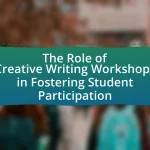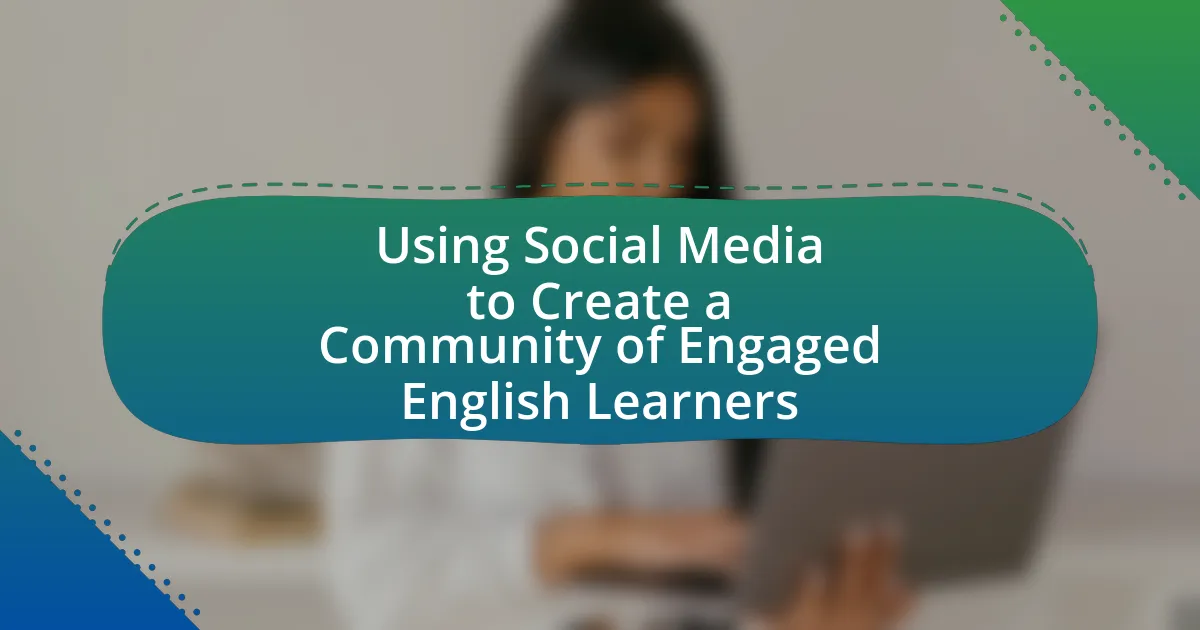Film adaptations are cinematic interpretations of literary works that transform narratives from books into visual storytelling, significantly enhancing accessibility and engagement with the original texts. This article explores the role of film adaptations in literature, examining how they differ from their literary sources, the elements commonly altered, and the reasons filmmakers choose specific works for adaptation. It also discusses the impact of adaptations on literary texts, the importance of visual storytelling techniques, and the critical discussions they provoke in literary studies. Additionally, the article highlights the challenges and critiques faced by adaptations, offering insights into best practices for engaging with both films and their literary counterparts in educational settings.
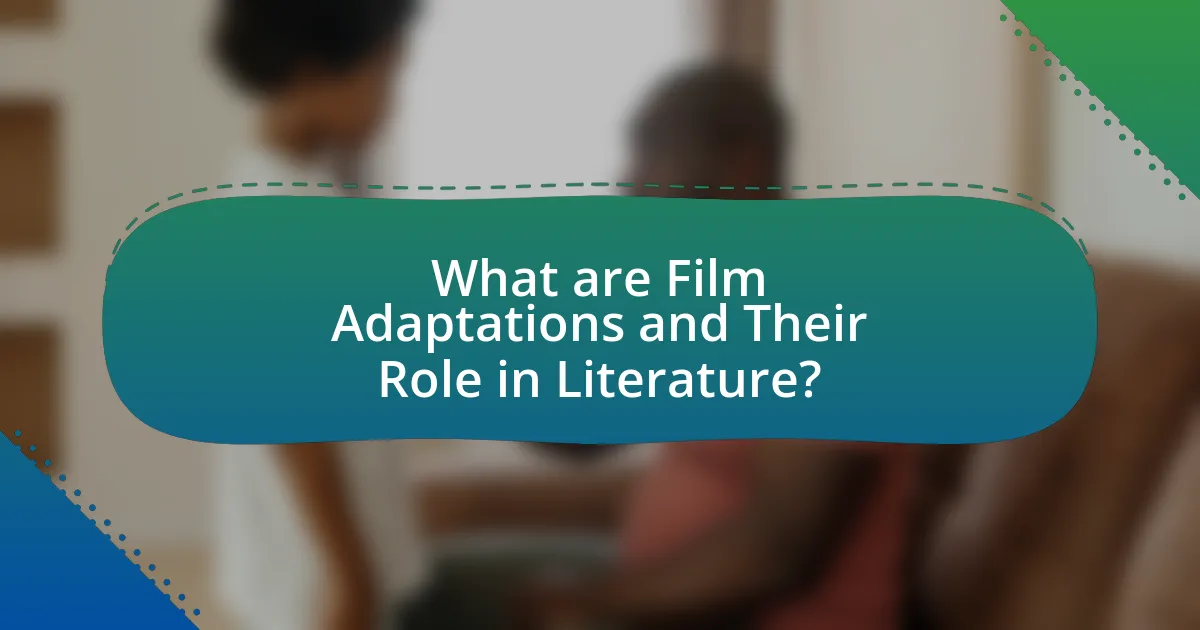
What are Film Adaptations and Their Role in Literature?
Film adaptations are cinematic interpretations of literary works, transforming narratives from books into visual storytelling. They play a significant role in literature by making stories accessible to broader audiences, often revitalizing interest in the original texts. For instance, adaptations like “The Great Gatsby” and “Pride and Prejudice” have led to increased sales and readership of the novels, demonstrating how films can serve as a bridge between literature and the public. Furthermore, adaptations can provoke discussions about themes, character interpretations, and cultural contexts, enriching the understanding of the source material.
How do film adaptations differ from their literary sources?
Film adaptations differ from their literary sources primarily in narrative structure, character development, and thematic emphasis. While novels often provide extensive internal monologues and detailed descriptions, films rely on visual storytelling and dialogue to convey the same elements, which can lead to significant alterations in character motivations and plot pacing. For instance, in the film adaptation of “The Great Gatsby,” the internal thoughts of the characters are largely omitted, resulting in a different interpretation of their relationships and motivations compared to F. Scott Fitzgerald’s original text. Additionally, films may condense or omit subplots to fit time constraints, which can alter the thematic focus; for example, the film version of “Harry Potter and the Order of the Phoenix” excludes certain character arcs and themes present in J.K. Rowling’s book, thereby changing the overall narrative experience. These differences highlight how adaptations can reshape the source material to suit the cinematic medium.
What elements are commonly altered in film adaptations?
Commonly altered elements in film adaptations include character development, plot structure, themes, and settings. Character development often sees simplification or alteration to fit the film’s runtime and audience engagement, as seen in adaptations like “The Great Gatsby,” where characters are less nuanced than in the original text. Plot structure frequently changes to enhance pacing or dramatic effect; for instance, “The Lord of the Rings” trilogy condensed multiple subplots for cinematic coherence. Themes may be emphasized or downplayed to resonate with contemporary audiences, as demonstrated in adaptations like “Pride and Prejudice,” which often highlight romance over social commentary. Lastly, settings can be modified or reimagined to suit visual storytelling, such as in “The Shining,” where the Overlook Hotel’s portrayal diverges from Stephen King’s description to create a more visually impactful atmosphere.
Why do filmmakers choose to adapt specific literary works?
Filmmakers choose to adapt specific literary works primarily because these texts often possess rich narratives, complex characters, and established audiences that can enhance the film’s appeal. Adaptations allow filmmakers to leverage the existing popularity of a literary work, as seen with adaptations like “Harry Potter” and “The Great Gatsby,” which have substantial fan bases and cultural significance. Additionally, literary works often provide deep thematic material and emotional depth, making them suitable for cinematic exploration. For instance, the adaptation of “To Kill a Mockingbird” not only brought attention to social issues but also attracted viewers who were already familiar with the novel’s powerful themes. This combination of audience familiarity and thematic richness makes literary adaptations a strategic choice for filmmakers.
What impact do film adaptations have on literary texts?
Film adaptations significantly influence literary texts by broadening their audience and enhancing engagement with the source material. When a novel is adapted into a film, it often reaches viewers who may not have otherwise read the book, thereby increasing its visibility and cultural relevance. For instance, the adaptation of “The Great Gatsby” has led to renewed interest in F. Scott Fitzgerald’s work, evidenced by a surge in book sales following the release of the 2013 film. Additionally, adaptations can spark discussions about themes, characters, and narrative techniques, prompting audiences to explore the original texts more deeply. This interaction between film and literature can lead to a richer understanding of both mediums, as seen in the case of adaptations like “To Kill a Mockingbird,” which has prompted critical conversations about race and justice in literature and film.
How can film adaptations enhance understanding of literary themes?
Film adaptations can enhance understanding of literary themes by providing visual and auditory representations that clarify complex ideas. These adaptations often interpret and emphasize key themes through cinematography, acting, and dialogue, making them more accessible to audiences. For instance, the film adaptation of “To Kill a Mockingbird” visually illustrates themes of racial injustice and moral growth, allowing viewers to engage with these concepts on a deeper emotional level. Additionally, adaptations can introduce new perspectives or interpretations, prompting discussions that deepen the audience’s comprehension of the original text’s themes.
What role do visual storytelling techniques play in interpreting literature?
Visual storytelling techniques play a crucial role in interpreting literature by enhancing comprehension and engagement with the text. These techniques, such as imagery, symbolism, and narrative structure, allow readers to visualize concepts and emotions, making abstract ideas more tangible. For instance, film adaptations often utilize visual elements to convey themes and character development that may be less accessible in written form. Research indicates that visual representations can significantly improve retention and understanding of literary themes, as seen in studies where students exposed to film adaptations demonstrated higher levels of engagement and analysis compared to those who only read the text. This integration of visual storytelling not only aids in interpretation but also fosters deeper discussions about the literary work, bridging the gap between text and audience.
Why are discussions about film adaptations important in literary studies?
Discussions about film adaptations are important in literary studies because they provide insights into the interpretation and transformation of literary texts into visual narratives. Analyzing how filmmakers adapt source material reveals the choices made in character development, plot structure, and thematic emphasis, which can differ significantly from the original work. For instance, the adaptation of “The Great Gatsby” has sparked debates about the portrayal of social class and the American Dream, highlighting how cinematic techniques can alter audience perception. Such discussions enhance understanding of both the literary work and its cultural impact, fostering a deeper appreciation for the complexities of storytelling across different mediums.
How do adaptations provoke critical thinking among audiences?
Adaptations provoke critical thinking among audiences by presenting familiar narratives in new contexts, encouraging viewers to analyze differences in themes, character development, and cultural interpretations. This process prompts audiences to question the choices made by filmmakers and how these choices affect the original message of the source material. For instance, adaptations like “The Great Gatsby” and its various film versions highlight shifts in societal values and character portrayals, leading audiences to critically assess the implications of these changes. Such analysis fosters deeper engagement with both the adaptation and the original text, enhancing understanding and appreciation of literary works.
What are the benefits of comparing films and their literary counterparts?
Comparing films and their literary counterparts enhances understanding of narrative techniques and thematic depth. This comparison allows audiences to analyze how different mediums interpret the same story, revealing unique insights into character development, plot structure, and thematic emphasis. For instance, adaptations often condense or alter plot elements to fit the film format, which can lead to discussions about the significance of these changes and their impact on the original message. Additionally, studies show that engaging with both forms can improve critical thinking skills and foster a deeper appreciation for literature, as seen in educational settings where film adaptations are used to stimulate interest in reading.
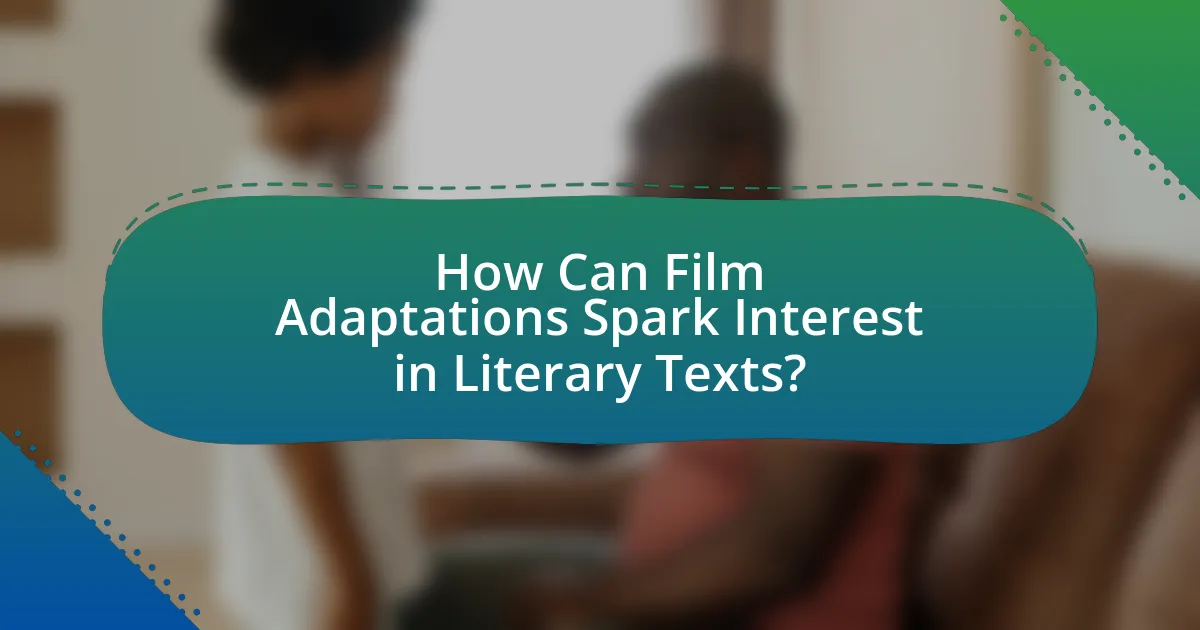
How Can Film Adaptations Spark Interest in Literary Texts?
Film adaptations can spark interest in literary texts by visually bringing stories to life, thereby attracting a broader audience. The cinematic portrayal of characters and settings often enhances emotional engagement, making the original literary work more accessible and appealing. For instance, adaptations like “The Great Gatsby” and “Pride and Prejudice” have led to increased sales and readership of the original novels, as evidenced by a surge in book sales following the release of their film versions. This phenomenon demonstrates how visual storytelling can serve as a gateway for audiences to explore and appreciate the source material.
What strategies can educators use to connect films with literature?
Educators can connect films with literature by using film adaptations as a tool for comparative analysis. This strategy involves analyzing the differences and similarities between the literary text and its film version, which can enhance students’ understanding of themes, character development, and narrative techniques. For instance, educators can facilitate discussions on how specific scenes are interpreted differently in the film compared to the book, encouraging critical thinking and deeper engagement with the text. Research indicates that students who engage in such comparative analysis demonstrate improved comprehension and retention of literary concepts, as highlighted in studies by the National Council of Teachers of English.
How can film screenings be integrated into literature curricula?
Film screenings can be integrated into literature curricula by using adaptations of literary texts to enhance understanding and engagement. Educators can select films that closely align with the themes, characters, and narratives of the literature being studied, allowing students to compare and contrast the two mediums. This approach fosters critical thinking and discussion, as students analyze the differences in interpretation and presentation between the text and its film adaptation. Research indicates that visual storytelling can aid comprehension, particularly for complex literary works, making the integration of film a valuable pedagogical tool. For example, studies have shown that students who engage with both the text and its film adaptation demonstrate improved analytical skills and a deeper appreciation for the source material.
What discussion prompts can be used to engage students with adaptations?
Discussion prompts that can engage students with adaptations include asking them to compare the themes of the original literary text with its film adaptation, such as “How does the film interpretation of the main theme differ from the book?” This prompt encourages critical thinking about the adaptation process. Another effective prompt is “What character changes in the film impact your understanding of their motivations?” This question allows students to explore character development and narrative choices. Additionally, asking “What visual elements in the film enhance or detract from the story compared to the text?” invites students to analyze the role of cinematography and visual storytelling in adaptations. These prompts are grounded in the educational practice of using film to deepen literary analysis, fostering engagement and discussion among students.
How do adaptations attract new audiences to classic literature?
Adaptations attract new audiences to classic literature by reinterpreting timeless stories through modern mediums, making them more accessible and relatable. For instance, film adaptations often incorporate contemporary themes, visual storytelling, and diverse casting, which resonate with current societal issues and attract viewers who may not engage with the original texts. A notable example is the 2012 film adaptation of “Les Misérables,” which brought Victor Hugo’s 19th-century novel to a new generation, resulting in increased interest in both the film and the original work. This phenomenon is supported by research indicating that adaptations can enhance audience engagement, as they often serve as entry points for deeper exploration of the source material.
What demographic trends are observed in audiences of literary adaptations?
Audiences of literary adaptations tend to show significant demographic trends, particularly in age, gender, and educational background. Research indicates that younger viewers, especially those aged 18 to 34, are more likely to engage with adaptations of popular literary works, as they often seek relatable content and visual storytelling. Additionally, women constitute a larger portion of the audience for literary adaptations, with studies showing that female viewers are more inclined to watch films based on novels, particularly in genres like romance and drama. Furthermore, individuals with higher education levels, such as college graduates, are more likely to appreciate and seek out literary adaptations, as they often have a greater familiarity with the source material. These trends highlight the intersection of demographic factors and audience preferences in the context of literary adaptations.
How can social media influence interest in both films and books?
Social media can significantly influence interest in both films and books by facilitating discussions, sharing recommendations, and creating viral trends. Platforms like Twitter, Instagram, and TikTok allow users to share their opinions and experiences, which can lead to increased visibility and curiosity about specific titles. For instance, the #BookTok trend on TikTok has led to a surge in sales for books like “It Ends With Us” by Colleen Hoover, demonstrating how user-generated content can drive interest. Additionally, film adaptations of popular books often generate buzz on social media, encouraging users to explore the original literary works. This interconnectedness between films and books on social media platforms amplifies audience engagement and interest in both mediums.
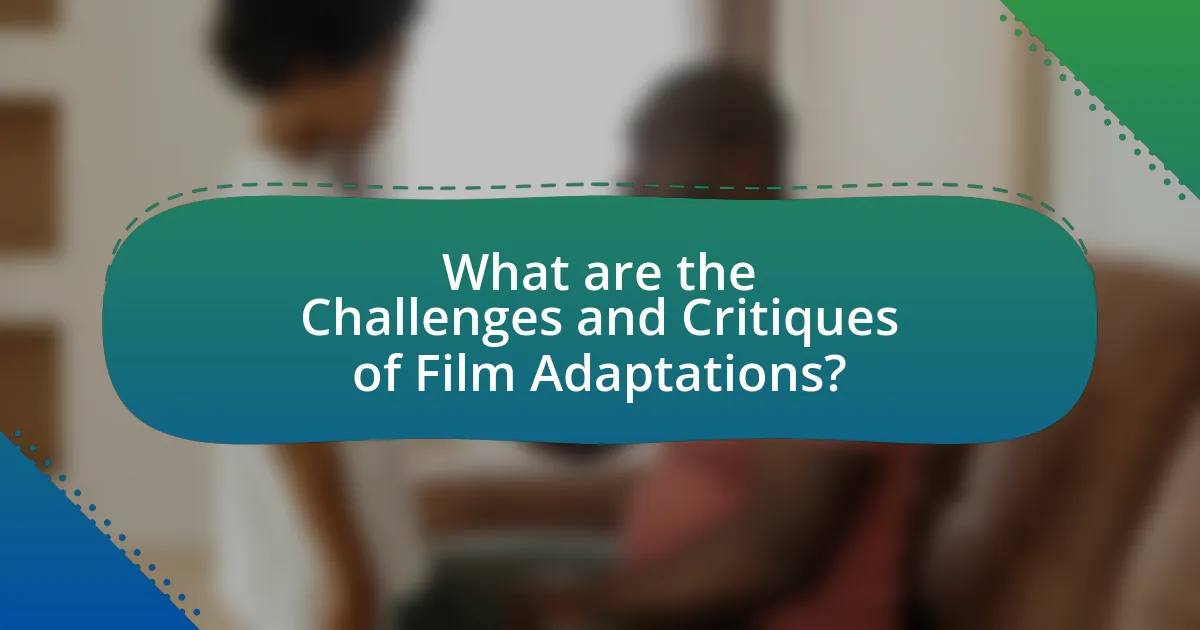
What are the Challenges and Critiques of Film Adaptations?
Film adaptations face several challenges and critiques, primarily related to fidelity to the source material, narrative compression, and audience expectations. Fidelity issues arise when filmmakers alter key plot points or characterizations, leading to dissatisfaction among fans of the original work. For instance, adaptations of popular novels often condense complex narratives into shorter runtimes, which can result in the loss of essential themes and character development. This compression can alienate viewers who are familiar with the depth of the source material. Additionally, audience expectations can create pressure on filmmakers to deliver a product that aligns with preconceived notions, which may not always be feasible or desirable. Critics often highlight these aspects, arguing that successful adaptations must balance artistic interpretation with respect for the original text to effectively engage both new viewers and loyal readers.
What common criticisms do film adaptations face from literary purists?
Film adaptations commonly face criticisms from literary purists for their perceived failure to accurately represent the source material. Literary purists argue that adaptations often omit key themes, character development, and narrative nuances present in the original texts. For instance, adaptations may condense complex plots into simplified storylines, leading to a loss of depth and meaning. Additionally, purists frequently criticize filmmakers for altering character motivations or relationships, which can distort the author’s original intent. This discontent is evident in discussions surrounding adaptations like “The Great Gatsby,” where critics noted significant deviations from F. Scott Fitzgerald’s portrayal of social themes and character intricacies.
How do adaptations handle the complexities of character development?
Adaptations handle the complexities of character development by condensing narratives and focusing on key traits to convey character arcs effectively. This process often involves selecting pivotal moments from the source material that highlight essential character traits and motivations, allowing audiences to grasp the character’s journey within a limited timeframe. For instance, in the film adaptation of “The Great Gatsby,” the character of Jay Gatsby is portrayed through selective flashbacks and visual symbolism, which encapsulate his ambition and tragic flaws, thus maintaining the depth of his character while making it accessible to viewers. This method of adaptation ensures that the essence of character development is preserved, even as the narrative is streamlined for cinematic storytelling.
What are the implications of changing plot points in adaptations?
Changing plot points in adaptations can significantly alter the narrative structure and character development, impacting audience perception and engagement. For instance, when a film adaptation modifies key events from the source material, it can shift thematic focus, potentially leading to a different interpretation of the story. This alteration can either enhance or detract from the original message, as seen in adaptations like “The Shining,” where changes in plot points led to a distinct psychological horror interpretation compared to Stephen King’s novel. Such modifications can also influence audience expectations and emotional responses, as viewers may connect differently with characters and their journeys based on these changes.
How can filmmakers address the challenges of adapting literature?
Filmmakers can address the challenges of adapting literature by focusing on the core themes and character arcs while making necessary adjustments for the visual medium. This approach allows filmmakers to maintain the essence of the source material while ensuring that the narrative is engaging for a cinematic audience. For instance, successful adaptations like “The Lord of the Rings” trilogy effectively condensed complex plots and developed characters through visual storytelling, which resonated with both fans of the books and new viewers. By prioritizing emotional depth and visual representation, filmmakers can create adaptations that honor the original work while appealing to a broader audience.
What techniques can be employed to remain faithful to the source material?
To remain faithful to the source material in film adaptations, techniques such as close textual analysis, character fidelity, and thematic preservation can be employed. Close textual analysis involves a detailed examination of the original work to identify key elements that must be retained, ensuring that the film captures the essence of the narrative. Character fidelity requires filmmakers to portray characters in a manner consistent with their original traits, motivations, and arcs, which helps maintain audience connection to the source. Thematic preservation focuses on retaining the central themes and messages of the original work, allowing the adaptation to resonate with the same emotional and intellectual impact as the source material. These techniques are supported by successful adaptations like “To Kill a Mockingbird,” which closely follows Harper Lee’s narrative structure and character development, demonstrating the effectiveness of these methods in creating a faithful representation.
How can filmmakers balance artistic interpretation with audience expectations?
Filmmakers can balance artistic interpretation with audience expectations by integrating creative storytelling techniques while remaining mindful of the source material’s core themes. This approach allows filmmakers to express their unique vision while ensuring that the adaptation resonates with viewers. For instance, successful adaptations like “The Great Gatsby” (2013) directed by Baz Luhrmann maintained the novel’s central themes of ambition and disillusionment while employing modern visual aesthetics and music to attract contemporary audiences. This method demonstrates that filmmakers can innovate within the framework of established narratives, thus satisfying both artistic desires and audience familiarity.
What are best practices for engaging with film adaptations in literary discussions?
Best practices for engaging with film adaptations in literary discussions include analyzing the differences between the text and the film, encouraging critical thinking about the adaptation choices, and fostering open dialogue among participants. Analyzing differences allows participants to explore how themes, characters, and narratives are transformed in the adaptation process, which can lead to deeper understanding of both the literary work and its cinematic interpretation. Encouraging critical thinking helps participants articulate their perspectives on why certain changes were made and how these changes affect the overall message or impact of the story. Fostering open dialogue creates a collaborative environment where diverse viewpoints can be shared, enhancing the discussion and promoting a richer appreciation of both the film and the original text.
